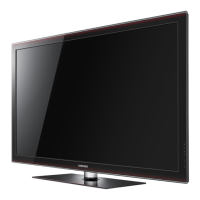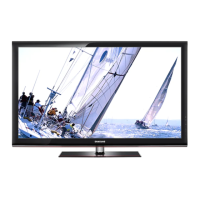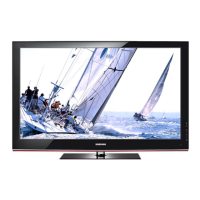Do you have a question about the Samsung PS50C670 and is the answer not in the manual?
Warning about static images causing screen burn-in.
Explains normal heat and cracking noises from the plasma panel.
Mentions cell defects and temperature limits for operation.
Warns about damage from prolonged static images and exclusion from warranty.
Lists included items and optional accessories for the TV.
Identifies and explains the TV's control panel buttons.
Details the functions of each button on the remote control.
Connecting antenna/satellite and performing Plug & Play initial setup.
How to connect AV devices using HDMI/DVI and Component/AV cables.
How to connect audio systems or headphones.
Using CI/CI+ cards and changing the device input source.
Explains menu navigation, button functions, and using the INFO button.
Using EPG for program scheduling and viewing channel lists.
Managing scheduled programs and channels.
Selecting antenna sources and performing automatic channel scanning.
Scanning channels manually and configuring satellite reception.
Editing channels and performing cable network searches.
Channel manager options and transferring channel lists via USB.
Accessing picture settings and energy-saving features.
Adjusting dynamic contrast, gamma, colour space, and white balance.
Setting picture size, screen mode, and noise filters.
Features like Film Mode, Pixel Shift, and Screen Burn Protection.
Connecting to PC and accessing the sound menu.
Adjusting voice clarity, balance, equalizer, and virtual surround.
Managing audio language, format, description, volume, and speaker output.
Selecting sound modes and configuring the TV clock and time zone.
Setting the TV to automatically turn off.
Setting timers and managing security features like Child Lock.
Setting menu language, teletext, and audio/subtitle preferences.
Setting subtitles and enabling digital text.
Game Mode, menu transparency, CI slots.
Running tests and upgrading TV software.
HD connection guide and contacting Samsung support.
Connecting a PC via HDMI/DVI or D-sub cables.
Supported PC resolutions and frequencies.
Connecting the TV to a local area network.
Methods for establishing a wired network connection.
Setting up network connection automatically via DHCP.
Setting up network connection manually for static IPs.
Requirements and methods for wireless network connection.
Using PBC (WPS) for easy wireless setup.
Automatically setting up a wireless network connection.
Connecting to devices directly without an access point.
Detailed steps for manual network configuration.
Playing media files from USB or PC.
How to connect and use USB storage devices for Media Play.
Playing media files from a PC over a network.
Important information before using Media Play, file systems, and device compatibility.
Navigating and displaying files in Media Play.
Steps for playing videos, including resume and seeking.
Lists compatible video file types, codecs, and resolutions.
Resuming movies and playing music files.
Displaying photos individually or as a slide show.
Selecting and playing multiple media files or groups.
Sorting media files by various criteria.
Playback options like picture size, sound, and subtitles.
Defines Anynet+ and its purpose for controlling Samsung devices.
How to connect Anynet+ devices to a home theatre system.
Using the menu to control connected Anynet+ devices.
Enabling Anynet+ and switching between devices.
How to record TV programs using a connected recorder.
Routing TV audio through an external receiver.
Common issues and solutions for Anynet+ features.
Overview of AllShare's functionality for device connectivity and media sharing.
Enabling Message, Media, and ScreenShare features.
Adding, allowing, or denying mobile devices in AllShare.
Viewing call, SMS, and schedule alerts via AllShare.
Displaying call/schedule alarms and media content.
Sharing mobile screens and controlling the TV with a phone.
How to use the analogue teletext service and navigate pages.
Instructions for wall mounting the TV and VESA specifications.
Using cable ties and installing the anti-fall device.
Solutions for common picture issues like distortion or color problems.
Solutions for common sound issues like no sound or low volume.
Troubleshooting for no image and channel reception problems.
Solutions for PC display errors and wireless network failures.
Covers remote control, humming noise, and other general problems.
Addressing burn-in, lost settings, intermittent loss, and other system problems.
Details on resolution, operating conditions, and system types.
Model, dimensions, weight, and disposal guidelines.
Details of Dolby, DTS, and DivX licences.
Guidelines for proper ventilation and installation clearances.
| Screen Size | 50 inches |
|---|---|
| Display Type | Plasma |
| Resolution | 1920 x 1080 pixels |
| HDMI Ports | 4 |
| USB Ports | 2 |
| Built-in Speakers | Yes |
| 3D | Yes |
| Refresh Rate | 600 Hz |
| Aspect Ratio | 16:9 |
| Built-in Wi-Fi | No |
| Smart TV | Yes |












